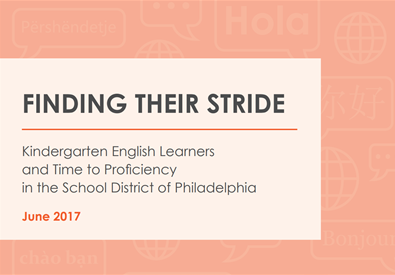By: Joshua Lin, Ruth Curran Neild
June 2017
Summary
Paralleling demographic shifts in the city, the School District of Philadelphia has seen an increase in its English learner (EL) population. By 2014-15, one in ten students was classified as an EL.
While ELs enter District schools at all ages and grades, they are most likely to enroll in the early elementary years. Almost 60% of the new English Learner entrants to the School District of Philadelphia between 2009–10 and 2013–14 were in kindergarten through third grade, with 37% entering as kindergartners.
The young age of these ELs presents both a challenge and an opportunity. The challenge is to help these young Philadelphia residents make two important transitions at one time: adapting to the unfamiliar faces, routines, and expectations of schooling, while also becoming proficient in a second language. The opportunity is that these young learners can achieve English proficiency early in their school years when they are given strong instruction and support for acquiring English. Proficiency, in turn, enables them to take full advantage of opportunities to learn grade-level academic content and skills.
This study provides evidence on the progress toward English proficiency of ELs who entered the District in kindergarten across four cohorts of students: 2008–09 through 2011–12. We examine students’ English proficiency upon entering school and the percentage who achieved proficiency within four years.
Our outcome measure was performance on a state-mandated assessment of English proficiencies needed to engage successfully with peers, teachers, and academic instruction in school: Assessing Comprehension and Communication in English State-to-State for English Language Learners (ACCESS). The ACCESS assessment must be administered every spring to any student whose home language is one other than English until the student meets the state’s standards for English proficiency and is reclassified as no longer needing linguistic support.
Key Findings
-
About two-thirds of kindergarten EL students knew and used minimal English when they entered school. Forty-nine percent of the kindergarten EL students placed at the lowest English language proficiency (ELP) level at entrance to school (ELP Level 1), and an additional 19% placed at ELP Level 2. About 32% of the kindergartners placed at ELP Levels 3, 4, 5, or 6.
-
The percentage of students who were more proficient in English at school entry increased across cohorts between 2008–09 and 2011–12. Twenty-seven percent of students in the 2008–09 cohort placed at an ELP Level 3 or above, compared to 41% of students in the 2011–12 cohort.
-
Almost 60% of kindergarten EL students achieved English proficiency within four years of starting school. By the end of first grade, 12% of the ELs who entered in kindergarten had achieved English proficiency, and an additional 17% were proficient by the end of second grade. By the end of third grade, an additional 30% reached English proficiency.
-
Some groups of students were more likely than others to achieve proficiency within four years. English proficiency rates were higher among female students and students who were not identified with a disability. Relative to Spanish speakers, students who spoke Arabic, Chinese, Khmer, or Vietnamese were more likely to achieve English proficiency within four years.
-
Students who were more proficient in English when they entered school were more likely to reach proficiency within four years. Fifty-three percent of students who entered at ELP Level 1 reached proficiency within four years, compared to 62% and 68% of students who entered at ELP Levels 2 and 3, respectively.
-
More students became proficient in oral language (listening and speaking English) than in literacy (reading and writing English). Within four years, 81% of kindergarten ELs were proficient in oral language, compared to 63% in literacy. A key driver of the lower proficiency rate in literacy is writing, with a 48% proficiency rate.
Policy and Implications
-
These analyses can inform goal-setting for schools tracking kindergarten ELs’ progress toward English proficiency. This study can help to set ambitious but achievable proficiency targets for future cohorts. Targets for ELs could be set based on students’ entering English proficiency levels.
-
High-quality pre-kindergarten for ELs may boost English proficiency at entrance to kindergarten. Philadelphia’s universal pre-kindergarten program provides an opportunity to help the city’s youngest ELs begin school with less catching up to do in English. Research indicates that quality pre-kindergarten experiences can help ELs make rapid growth in both English proficiency and academic skills.
-
An area for continued work is supporting ELs to develop proficiency in writing. Given the substantial disparity in proficiency rates between writing and the other three language domains (speaking, listening, and reading), the District may want to develop a stronger focus on supporting these students to become effective writers in English.

